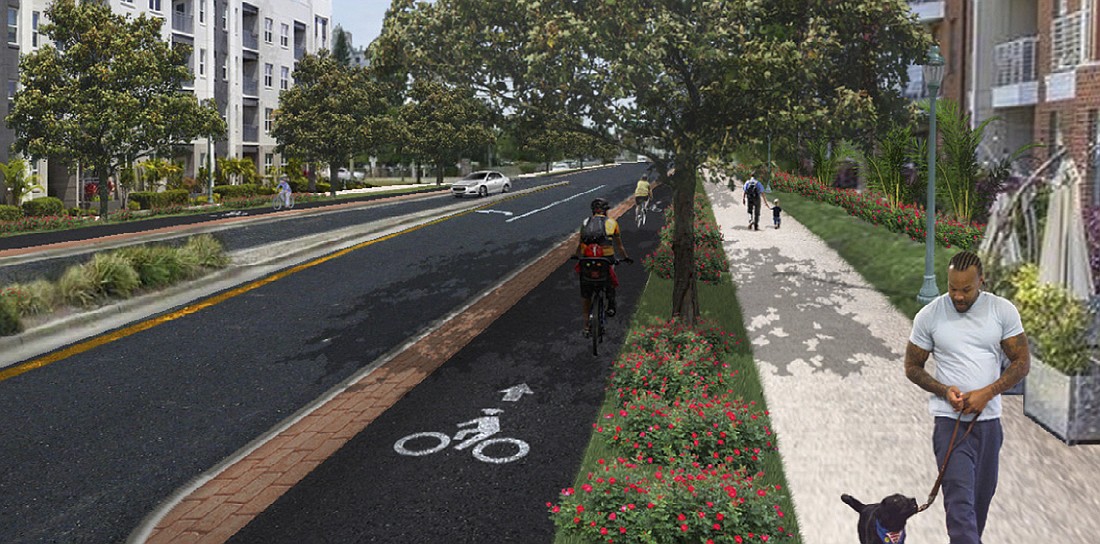- December 5, 2025
-
-
Loading

Loading

Beginning in the 1960s, planners in Sarasota embarked upon a two-decade effort to widen roads along major transportation routes, hoping to address traffic congestion concerns associated with growth.
Road design decisions were made primarily to serve drivers. Consequently, the projects created a more hostile environment for pedestrians and cyclists in the city — and the effects of these decisions are still being felt by Sarasota residents today.
That’s the historical argument city staff puts forward in the full draft of the Sarasota in Motion transportation master plan, which the city released last week for public review. It’s part of a larger case planning officials are making for a suite of projects that prioritize walking and biking improvements, placing less emphasis on initiatives specifically focused on vehicular transportation.
One reason to go in that direction, the plan says, is because the city has already built a transportation network that prioritizes drivers at the expense of everyone else.
“The growth of traffic and the widening of roadways became barriers to walking and biking between destinations like downtown and the adjacent neighborhoods,” the master plan stated. “Many of these widening efforts and unintended negative impacts remain in place today.”
Planning staff says there are lots of other reasons to prioritize walking, biking and transit as the city looks to the next 25 years of transportation in Sarasota. For one, they say it’s reflective of what the public has said it wants to see in a series of surveys and meetings. And Colleen McGue, the city’s chief transportation planner, emphasized that every additional trip made on foot or on a bike can take a car off the roadway, which means multimodal projects offer benefits for drivers too.
Still, with the City Commission scheduled to review the Sarasota in Motion plan for adoption later this summer, there are some vocal skeptics. At a May 18 commission meeting where staff presented the top 10 projects included in the master plan, Commissioner Hagen Brody said he feared there was a lack of substantive data used to guide the transportation recommendations. He was also critical of the focus on alternative modes of transportation.
“There’s virtually no projects you presented that have anything to do with accommodating increased traffic volume,” Brody said. “This is all a bunch of sidewalks, bicycles and electric cars.”
The plan has also drawn input from an interested official in a neighboring jurisdiction. On June 7, Longboat Key Vice Mayor Mike Haycock sent an email to the City Commission expressing his concerns about Sarasota in Motion. Although he was complimentary of the bike and pedestrian improvements staff recommended, he thought the projects gave too much weight to safety and beautification in the downtown area.
McGue said it was important not to downplay the importance of safety. The full draft of the master plan includes a series of policy recommendations, one of which is the adoption of a “vision zero” program. Vision zero is a strategy adopted in communities across the country that seeks to eliminate all traffic-related fatalities, developed around the belief that those deaths are preventable and are the result of conscious planning decisions that can be undone.
McGue noted that the Sarasota region ranked as the fourth most dangerous place in the country for pedestrians in a 2019 report.
“If you asked me if I wanted it to take longer to drive somewhere, I would say no,” McGue said. “But I think when it comes to the greater good and making sure we’re killing fewer people in our roads, that’s something we have to give more importance.”
McGue disputed the notion that bicycle and pedestrian improvements necessarily meant more vehicular congestion. She said planners consider widening roads an ineffective approach for reducing traffic and that survey results showed residents didn’t consider more travel lanes a high priority.
She also said designing road capacity for the busiest time of the year can create safety issues during nonpeak seasons, encouraging speeding and providing a less comfortable environment for pedestrians and cyclists.
“We have to really look at congestion in a comprehensive way, and our streets need to serve all the people who are using them all year-round,” McGue said. “The more vehicle capacity we have on the roadways — that’s great when everyone’s here, and the roads are packed in season — but it can actually make our streets more dangerous when we’re not in season.”
Staff estimates the master plan will cost a total of $118.4 million to implement over the course of 25 years. McGue said the plan only recommends implementing three specific projects in the next five years, a reflection of potential budget shortages associated with the economic effects of COVID-19.
McGue knows that the proposal will continue to draw scrutiny, particularly with those who want to see more of a focus on vehicular projects. But city staff believes the master plan is reflective of public input, local data and planning best practices.
“This is really the plan that is well-suited to this moment in Sarasota’s history and the plan that people have been asking for,” McGue said. “We feel very confident with those recommendations.”